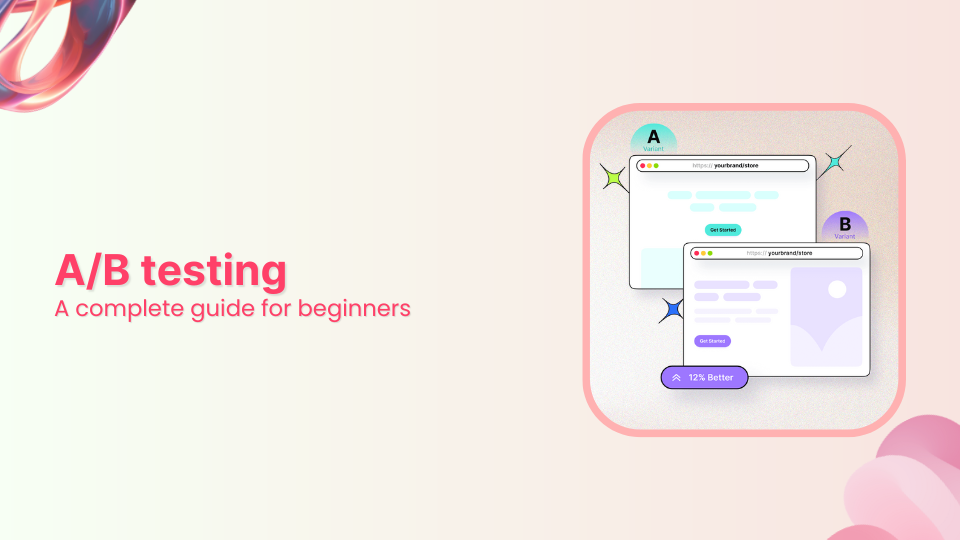A/B testing is a popular digital marketing strategy used by conversion specialists when trying to improve website conversion. This test involves a side-by-side test of two or more options to find which one performs better than the rest.
Let’s understand A/B testing, its types, benefits, and examples to ensure every beginner who hasn’t tried A/B testing can get off to a good start.
What is A/B testing?
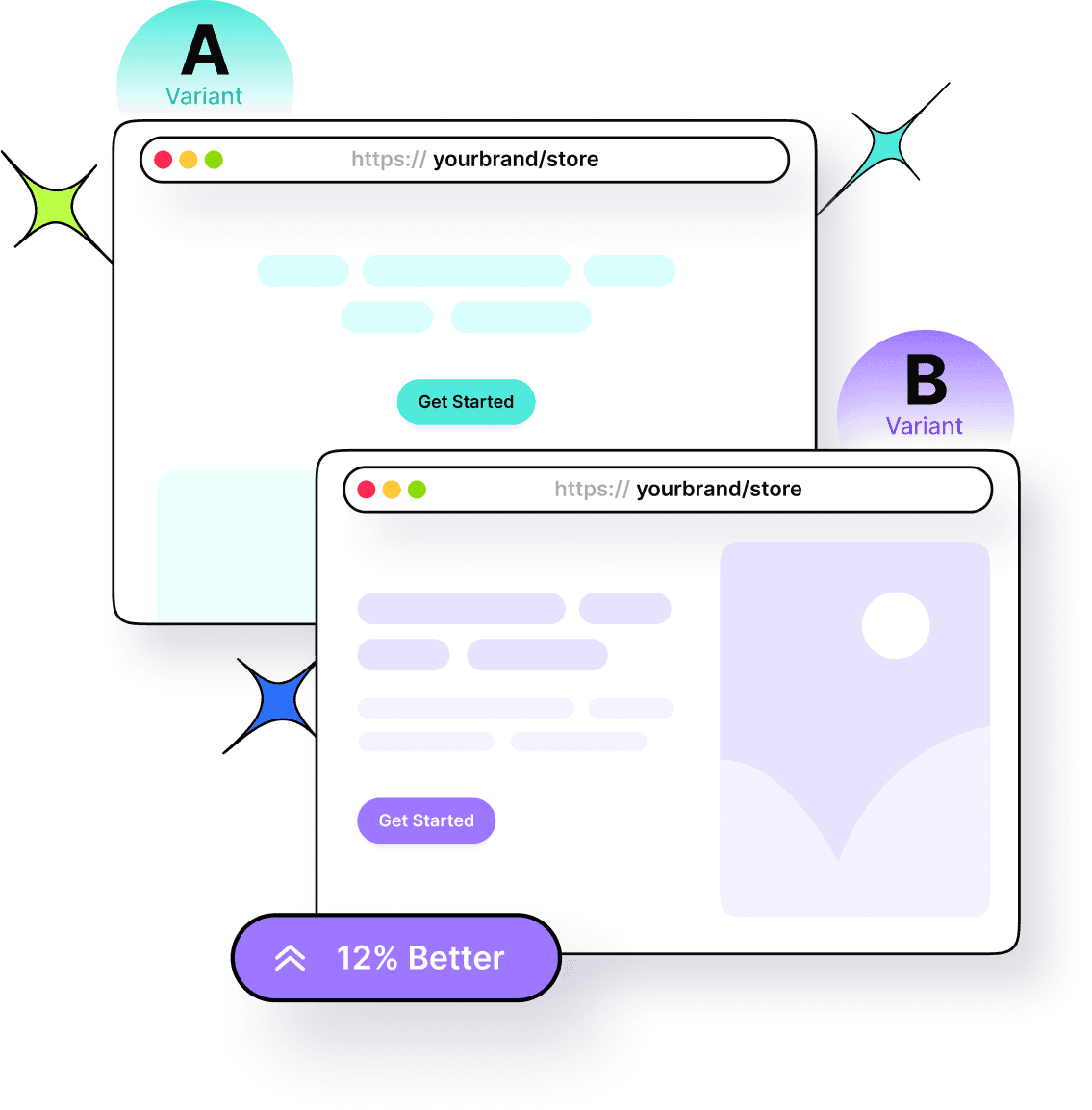
The A/B testing is a comparison of two or more cases only to find out which works better than the other one. The purpose of an A/B testing campaign is to uncover the better-performing option out of all.
It’s a powerful analysis strategy used in online advertising, email marketing, social media publishing, website conversion, and several other areas.
The goal of an A/B testing campaign is to see which option outperforms the other one.
For instance, a brand does side-by-side testing of two Facebook ad units under the same ad set. It can see which ad unit performs better than the other one by comparing the ad results.
Link Management Made Easy
Your go to link management tool for CTAs, branded and bio links, QR Codes, tracking and retargeting.
Get Started for FREE!
Types of A/B tests
Three types of A/B testing are widely popular in the digital marketing space:
1. Split testing
Split testing is a type of A/B testing in which a user creates a new version of an existing landing page, logo, or banner ad and compares it to the original to determine which one achieves better performance metrics. It works best when the user wants to overhaul the entire design of a landing page without altering the current version.
2. Multivariate testing
Multivariate testing is yet another useful A/B testing type that allows marketers to examine multiple variables simultaneously to identify the most effective combination of elements on a page. Unlike A/B testing, which focuses on testing one version against another, MVT involves creating numerous variant pages where different elements, such as headlines, images, buttons, and text) are altered. This A/B testing type is more complex and data-intensive as compared to the previous one.
3. Multi-page testing
Multi-page testing plays around with specific elements, such as the call-to-action button, and analyzes their impact across several pages within a user journey. It comes in handy when users want to understand how modifications to a consistent element affect user interactions and conversions throughout the entire funnel.
Role of A/B testing in marketing
Let’s understand the role of A/B testing in marketing and find out what difference it can make along the way:
- A major role of A/B testing is to provide undeniable evidence based on the data to make marketing or branding decisions. The process enhances user experience and optimizes marketing strategies. For instance, businesses can test different headlines, images, call-to-action buttons, or overall layouts to see which elements resonate most with their audience.
- 58% of companies use A/B testing for optimizing their conversion, whereas 35% of companies plan to use A/B testing for conversion optimization. Furthermore, 60% of the brands believe A/B testing is crucial to conversion optimization.
- One of the important roles of A/B testing in digital marketing is risk mitigation. Before implementing broad changes across an entire user base, companies can test on a smaller scale to ensure the modifications will have the desired positive impact. This approach minimizes potential negative effects on user engagement and conversion rates.
- A/B testing also fosters continuous improvement on the website or application. By regularly conducting such tests, businesses can keep up with evolving user preferences and market trends, thereby maintaining a competitive edge. This iterative process helps in fine-tuning engagement strategies on the website or app to incrementally boost performance over time.
- It’s crucial for personalizing user experiences. By analyzing which versions work best for different audience segments, marketers and conversion experts can tailor their content and offerings to meet specific needs and preferences, resulting in a better response from the target audience.
Benefits of A/B testing
A/B testing strategy has been around for years. There are numerous benefits of applying the A/B testing strategy that have helped brands and marketers increase attention and sales over the years. Here are the six of many benefits of A/B testing:
1. Get more user engagement
User engagement means how long users stick around when they visit a website or open an app. The longer the users stay, the higher the chances of sales. One of the benefits of A/B testing is that it can significantly improve the user engagement of a company.
A/B testing ensures that the business gets to choose the better versions of the website or app layout, color scheme, CTA color and text, landing page copy, and other elements.
2. Skyrocket conversion rate
Marketers and conversion experts always A/B test different sections of the website or landing page. Their ultimate goal is to increase the conversion rate of the business. Therefore, they make all necessary changes to test things out until they find the best combination.
The website or app elements that play a vital role in improving the conversion rate are call-to-action, website copy, headlines, colors, fonts, layout/design, etc. Undoubtedly, A/B testing is crucial to increasing conversion rates regardless of the industry.
3. Decline in the bounce rate
Bounce rate is the percentage of visitors that quickly leave the website or page without taking any noticeable action on the platform. No wonder digital marketers strive to reduce the bounce rates of their sales pages at any cost. Therefore, they tweak all sorts of things, for instance, the sales page design, layout colors, website fonts, CTA text, etc.
The purpose is to stop people from bouncing off the site without engaging with the site or app. A/B testing helps them figure out which combination of CTAs, colors, page designs, and website copy performs better than the others.
4. Low cart abandonment
Cart abandonment is a pain point for many e-commerce businesses and online retailers. Businesses use different engagement and remarketing tactics to reduce cart abandonment.
One of the perks of A/B testing is that it could impact the conversion process and eventually reduce cart abandonment. Businesses can A/B test the pricing model, UI/UX, CTA buttons, color scheme, and website copy just to see how this experiment works out for them.
Related: Abandoned Cart Emails That Actually Convert
4. Test URL performance
Influencers and brands create and manage URLs very carefully. They know that URLs have a huge role to play in the SEO and social media marketing. Marketers, influencers, and brands A/B test two or more versions of the same URL to see how the audience responds to those URLs.
Link Management Made Easy
Your go to link management tool for CTAs, branded and bio links, QR Codes, tracking and retargeting.
Get Started for FREE!
Replug is an all-in-one URL management tool that allows marketers and brands to A/B test their URLs. Ultimately, it helps brands and experts understand URL performance across different platforms.
5. Understand user behavior
A/B testing isn’t just about picking up the better website copy, CTA buttons, and website design. Instead, it goes beyond the basic website structure. User behavior is a vital engagement metric that showcases the effectiveness of the website or app design philosophy.
Understanding user behavior on the website or landing and making changes can save time, effort, money, and energy. A/B testing provides businesses a chance to understand user behavior better than ever.
Read more: Benefits of A/B testing
What elements can you A/B test?
Several website or app elements can be analyzed with A/B testing. Let’s take a look:
1. Website or app layout
The layout design is an integral part of the UI/UX. Testing different layout designs and applying changes to the elements’ arrangement can reveal which layout maximizes user engagement and conversion.
You may also like: How to create high-converting landing pages
2. Email subject line
Email marketing is an essential part of the digital marketing campaign. A/B testing different email subject lines to find out which one has the highest open rate can be extremely helpful. Understanding what wording resonates most with your audience and increases email engagement can improve the overall performance of the campaign.
3. Banner ad design
Banner ad design is a vital element when A/B testing different elements of the marketing campaign. Creating and testing different variations of design elements such as images, text, and layout in banner ads can determine which version attracts more clicks and conversions. Optimizing the visual appearance can improve the effectiveness of the advertising.
4. Call-to-action buttons
Create compelling Call-to-Actions to boost conversions
Improve your click through rate by creating catchy CTAs for your marketing campaigns.
Get Started For Free!
Call-to-actions can shape the outcome of the marketing campaign, especially when all other elements are up to the mark. It’s recommended to test different texts, sizes, colors, and placements of call-to-action buttons. A/B testing multiple CTA buttons can help determine the winning combination.
Try Replug’s Free CTA Generator to get the best results.
5. Color scheme
One of the elements to test out when A/B testing is the color scheme regardless of the product. Try out different color schemes to see which one enhances user experience and improves engagement. Not only does it impact the design and aesthetics of a website or app, but it also influences the user’s behavior toward the web or app.
When to run A/B tests
Here are some of the situations when running A/B tests are extremely helpful:
- Striving to improve conversion rate: A/B testing can be pretty useful when you’re struggling with conversion rate. The course of action in this case is to make alterations on the website or landing page to make your offer more impactful. To see how these changes work out, you have to A/B test and see how things turn out.
- Trying to increase CTA clickability: Call-to-actions are important for sales, lead generation, and sign-ups no matter what industry or niche you work in. A/B test in your CTA buttons to see what difference it makes. Always experiment with the CTA size, text, colors, and shape for better results.
- Comparing URL performance: URLs are an essential part of the digital marketing strategy. A/B testing comes in handy when you want to compare two or more URLs leading to the same destination.
- Optimizing landing pages for more engagement: A/B testing is crucial to the landing page optimization process. Since the purpose of optimization is to improve page performance, A/B testing elevates landing page outcomes by providing data-backed results. So, brands should run A/B testing when they want more traction, engagement, and conversion on their online real estate.
Therefore, don’t shy away from trying A/B tests if you’re trying to achieve any of the above-mentioned marketing goals.
A/B testing examples with outcomes
WorkZone boosts leads by 34% through testimonials page
WorkZone, a US-based software company specializing in project management solutions and documentation collaboration tools, aims to maximize conversions. To enhance brand reputation, they added a customer review section beside the demo request form on their lead generation page. However, the colorful testimonial logos distracted visitors from filling out the form.
Variant A
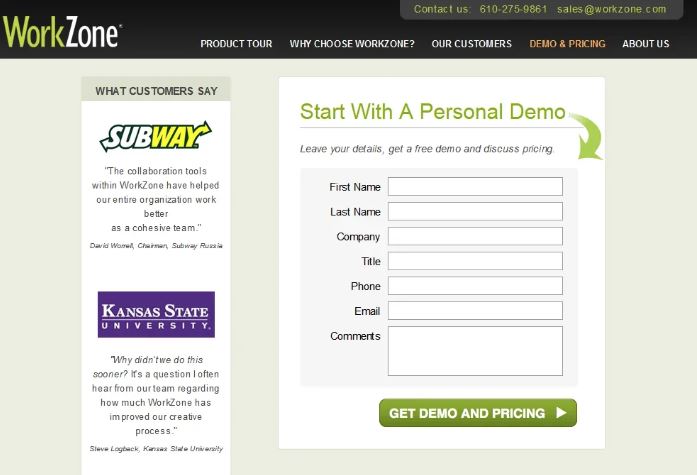
Variant B

To address this, WorkZone changed the testimonial logos to black and white and tested the impact. After 22 days, the results showed a 34% increase in form submissions, with a 99% statistical significance, demonstrating the success of this adjustment.
Thrive Themes increases sales by 13% through sales page optimization

Thrive Themes decided to test a new feature on its landing pages—customer testimonials. Previously, their control page featured a banner highlighting product features without customer feedback. The team conducted a 6-week A/B test, comparing the control with an updated page including testimonials. The result was a 13% increase in sales, with the conversion rate rising from 2.2% to 2.75%.
Obama campaign boosts sign-ups by 40.6% through A/B testing
One of the popular A/B testing examples is from Obama’s campaign for the presidency. Dan Siroker was the Director of Analytics for the Obama campaign. He went on to perform different A/B tests on the campaign landing page to see what increases sign-up and donation rates.
The original landing page has had the following properties:

Image source
- Sign up as a CTA button
- Solo picture of Obama, associated CTA media, and copy that says, “GET INVOLVED”
Then, the team started A/B testing and came up with a new landing page design. It consisted of the following properties:

- Learn More as a CTA button text
- Obama family picture and the associated CTA media and copy that says, “Change We Can Believe In”
The results of these changes were astonishing. It was reported that the highlighted changes brought in a 40.6% increase in email sign-ups and an additional $60 million in donations.
Do’s & Don’ts when running an A/B test
A/B testing requires time, money, and resources, so brands and experts try to avoid any mistakes during the process. Understanding the dos and don’ts of running an A/B test can significantly reduce the chances of any expected upheaval during the experiment.
Here are the important do’s and don’ts to remember when getting started with A/B testing:
| Do’s | Don’ts |
| Define clear goals: | Changing test parameters halfway through |
| Segment your audience | Ignore the importance of randomization |
| Run tests simultaneously | Test multiple variables simultaneously |
| Use sufficient sample size | Relying on short-term data |
| Test one variable at a time | Overlooking external factors |
Also read: SEO Split Test Your Way To Higher Search Engine Ranking
Do’s When Running an A/B Test
Here we go:
- Define clear goals: Establish specific, measurable objectives before starting the A/B test to ensure meaningful results and start on the right foot.
- Segment your audience: Properly segment your audience to ensure that the test groups are representative and comparable.
- Run tests simultaneously: Conduct the tests at the same time to avoid seasonal or time-based biases. Otherwise, the results might not be accurate.
- Use sufficient sample size: Ensure your sample size is large enough to yield statistically significant results. No one wants to make their A/B look irrelevant.
- Test one variable at a time: Focus on a single element (e.g., headline, CTA) to accurately attribute changes in performance. It will also help you portray the results more clearly.
Don’ts of running an A/B Test
- Changing test parameters halfway through: Avoid altering the test setup or criteria once the test has started to maintain integrity. Any alteration, delay, or pause during the process might ruin the gist of the A/B test.
- Ignore the importance of randomization: Ensure random assignment of participants to eliminate selection bias. Ignoring randomization would be a huge mistake.
- Relying on short-term data: Avoid making decisions based on data collected over too short a period; let the test run its course.
- Testing multiple variables simultaneously: Testing several changes at once makes it difficult to determine which one caused the effect.
- Overlooking external factors: Consider external influences like holidays or market trends that might skew results.
Link Management Made Easy
Your go to link management tool for CTAs, branded and bio links, QR Codes, tracking and retargeting.
Get Started for FREE!
A/B test with Replug
Replug is a top gun when it comes to URL tracking and link management. One of the features of this tool is A/B testing. Let’s learn how to use Replug for A/B testing:
Step 1: Sign up for a Replug account if you haven’t already.
Once it’s done, log in to your Replug account to get started.

Step 2: After logging in to your account, you’ll land on the Replug dashboard.
Go to the Manage drop-down menu from the top and choose the Campaign section.

Now, click the New Campaign button to create a new campaign (if it’s your first time).
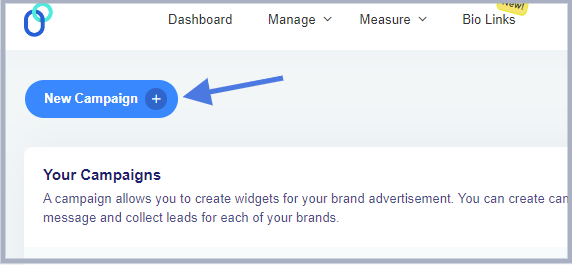
Step 3: Go to the dashboard; you’ll see the “Create Quick Replug Link” option. This is where you can start creating the short link to track and A/B test.
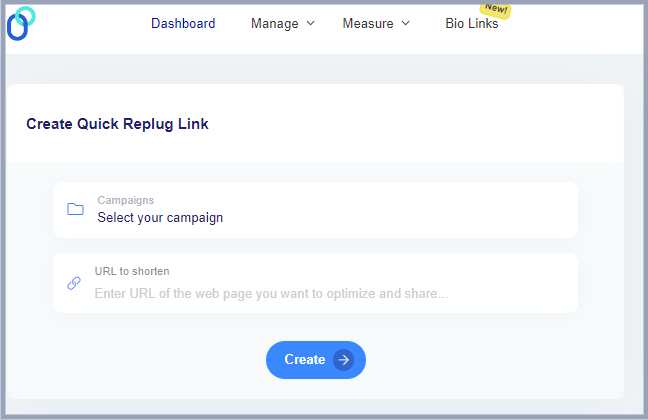
Select the campaign you have already created, and provide the link to the A/B test. Go ahead and create the short link.
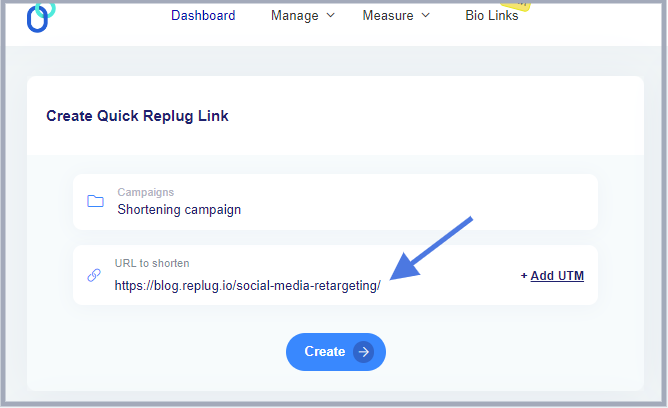
Step 4: Once the short link is created, a popup window will appear with the settings for the very short link.
Now, enable A/B testing by toggling the AB testing button before saving the link. This process will set the default destination URL as the first A/B test link with 100% weightage.
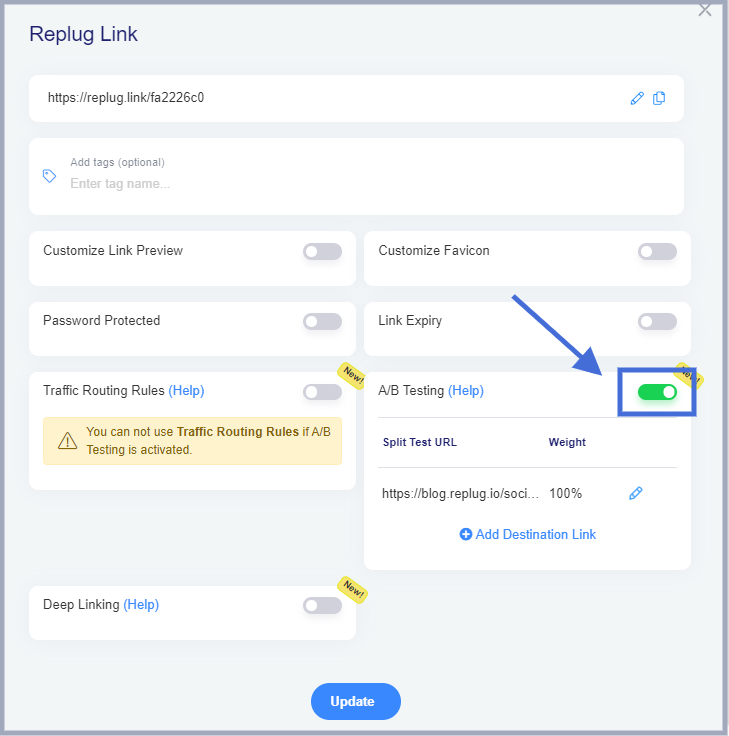
Add more destination links by clicking on the Add Destination Link.
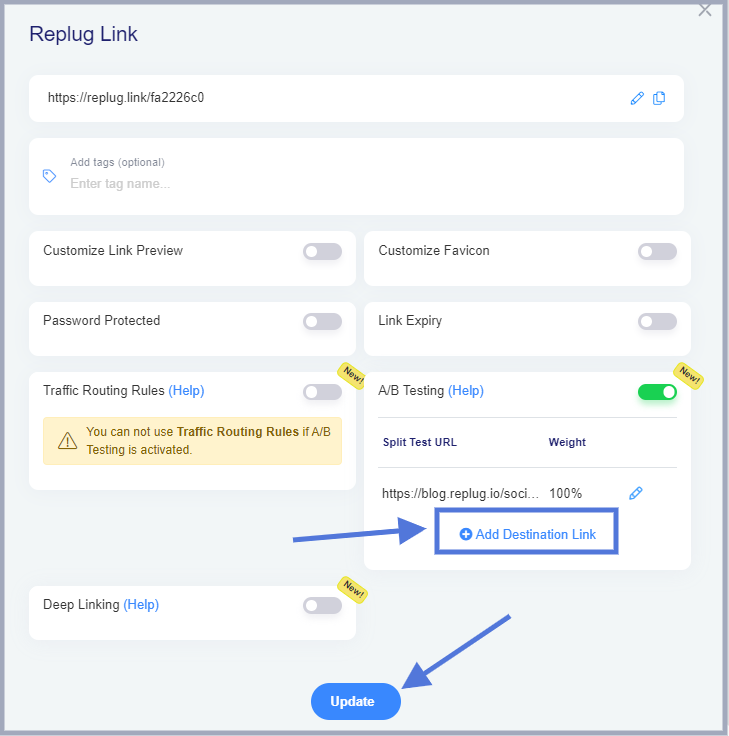
Note: Allocate the weightage to the A/B test links. You can equally distribute it or allocate different weightage to the specific links.
Once you’re done, press the update button and you’re all set to start A/B testing with Replug.
Related: How to Do A/B Testing the Easy Way: Step-by-Step Guide
FAQs about A/B testing
Let’s answer some of the frequently asked questions about A/B testing:
How many ab tests are successful?
There is no definite answer to this question. However, there are hundreds of thousands of examples of very successful A/B test experiments that vouch for the effectiveness of this strategy.
Why is it called AB testing?
It’s a strategy in which a user generally tests option A against option B to find out which performs better than the other one. That’s why it’s called A/B testing (also known as split testing or bucket testing).
What is the future of AB testing?
The future of A/B testing seems extremely bright. A/B are testing SAAS tools available that take this testing and analysis tactic to the next level. It’s safe to say that A/B testing is getting bigger and bigger with time.
Does AB testing affect SEO?
A/B testing can have a significant effect on the SEO. Since A/B testing impacts UI/UX, engagement, conversion, and CTR, it could affect SEO. Whoever knows SEO also knows that SEO isn’t just about keywords. It involves design, speed, engagement, links, clickability, and much more.
When not to use ab testing?
A/B testing shouldn’t be used when external factors, such as the holiday season or certain market trends, are making tides. Plus, other signals tell us that it’s not the right time for A/B testing. Refer to the “Don’ts When Running an A/B Test” section of this article.
Can you run multiple ab tests?
Running multiple A/B tests seems like a mistake because it is hard to determine which specific change affected the outcome of the campaign.






























